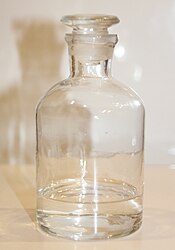Oxolane
|
|
|||
 |
|||
| Names | |||
|---|---|---|---|
|
Preferred IUPAC name
Oxolane
|
|||
|
Systematic IUPAC name
1,4-Epoxybutane
Oxacyclopentane |
|||
| Other names
Tetrahydrofuran
Butylene oxide Cyclotetramethylene oxide Diethylene oxide Tetra-methylene oxide |
|||
| Identifiers | |||
|
3D model (JSmol)
|
|||
| Abbreviations | THF | ||
| ChEBI | |||
| ChEMBL | |||
| ChemSpider | |||
| ECHA InfoCard | 100.003.389 | ||
|
PubChem CID
|
|||
| RTECS number | LU5950000 | ||
|
|||
|
|||
| Properties | |||
| C4H8O | |||
| Molar mass | 72.11 g·mol−1 | ||
| Appearance | colorless liquid | ||
| Odor | ether-like | ||
| Density | 0.8892 g/cm3 at 20 °C, liquid | ||
| Melting point | −108.4 °C (−163.1 °F; 164.8 K) | ||
| Boiling point | 66 °C (151 °F; 339 K) | ||
| Miscible | |||
| Vapor pressure | 132 mmHg (20 °C) | ||
| Viscosity | 0.48 cP at 25 °C | ||
| Structure | |||
| envelope | |||
| 1.63 D (gas) | |||
| Hazards | |||
| Safety data sheet | See: data page | ||
|
EU classification (DSD) (outdated)
|
Flammable (F) Irritant (Xi) |
||
| R-phrases (outdated) | R11, R19, R20/21/22, R36/37 | ||
| S-phrases (outdated) | S16, S29, S33 | ||
| NFPA 704 | |||
| Flash point | −14 °C (7 °F; 259 K) | ||
| Explosive limits | 2%–11.8% | ||
| Lethal dose or concentration (LD, LC): | |||
|
LD50 (median dose)
|
1650 mg/kg (rat, oral) 2300 mg/kg (mouse, oral) 2300 mg/kg (guinea pig, oral) |
||
|
LC50 (median concentration)
|
21000 ppm (rat, 3 hr) | ||
| US health exposure limits (NIOSH): | |||
|
PEL (Permissible)
|
TWA 200 ppm (590 mg/m3) | ||
|
REL (Recommended)
|
TWA 200 ppm (590 mg/m3) ST 250 ppm (735 mg/m3) | ||
|
IDLH (Immediate danger)
|
2000 ppm | ||
| Related compounds | |||
|
Related heterocycles
|
Furan Pyrrolidine Dioxane |
||
|
Related compounds
|
Diethyl ether | ||
| Supplementary data page | |||
|
Refractive index (n), Dielectric constant (εr), etc. |
|||
|
Thermodynamic
data |
Phase behaviour solid–liquid–gas |
||
| UV, IR, NMR, MS | |||
|
Except where otherwise noted, data are given for materials in their standard state (at 25 °C [77 °F], 100 kPa).
|
|||
|
|
|||
| Infobox references | |||
Tetrahydrofuran (THF) is an organic compound with the formula (CH2)4O. The compound is classified as heterocyclic compound, specifically a cyclic ether. It is a colorless, water-miscible organic liquid with low viscosity. It is mainly used as a precursor to polymers. Being polar and having a wide liquid range, THF is a versatile solvent.
About 200,000 tonnes of tetrahydrofuran are produced annually. The most widely used industrial process involves the acid-catalyzed dehydration of 1,4-butanediol. Ashland/ISP is one the biggest producers of this chemical route. The method is similar to the production of diethyl ether from ethanol. The butanediol is derived from condensation of acetylene with formaldehyde followed by hydrogenation.DuPont developed a process for producing THF by oxidizing n-butane to crude maleic anhydride, followed by catalytic hydrogenation. A third major industrial route entails hydroformylation of allyl alcohol followed by hydrogenation to 1,4-butanediol.
THF can also be synthesized by catalytic hydrogenation of furan.Certain sugars can be converted to THF, although this method is not widely practiced. Furan is thus derivable from renewable resources.
...
Wikipedia



